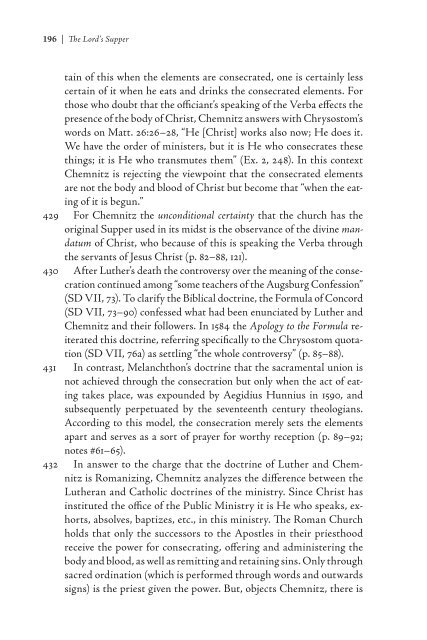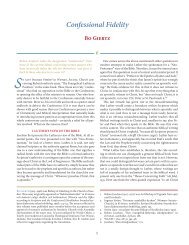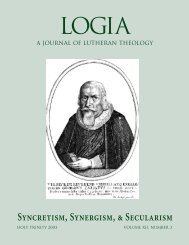The Lord's Supper in the Theology of Martin Chemnitz Bjarne - Logia
The Lord's Supper in the Theology of Martin Chemnitz Bjarne - Logia
The Lord's Supper in the Theology of Martin Chemnitz Bjarne - Logia
Create successful ePaper yourself
Turn your PDF publications into a flip-book with our unique Google optimized e-Paper software.
| <strong>The</strong> Lord’s <strong>Supper</strong><br />
ta<strong>in</strong> <strong>of</strong> this when <strong>the</strong> elements are consecrated, one is certa<strong>in</strong>ly less<br />
certa<strong>in</strong> <strong>of</strong> it when he eats and dr<strong>in</strong>ks <strong>the</strong> consecrated elements. For<br />
those who doubt that <strong>the</strong> <strong>of</strong>ficiant’s speak<strong>in</strong>g <strong>of</strong> <strong>the</strong> Verba effects <strong>the</strong><br />
presence <strong>of</strong> <strong>the</strong> body <strong>of</strong> Christ, <strong>Chemnitz</strong> answers with Chrysostom’s<br />
words on Matt. 26:26–28, “He [Christ] works also now; He does it.<br />
We have <strong>the</strong> order <strong>of</strong> m<strong>in</strong>isters, but it is He who consecrates <strong>the</strong>se<br />
th<strong>in</strong>gs; it is He who transmutes <strong>the</strong>m” (Ex. 2, 248). In this context<br />
<strong>Chemnitz</strong> is reject<strong>in</strong>g <strong>the</strong> viewpo<strong>in</strong>t that <strong>the</strong> consecrated elements<br />
are not <strong>the</strong> body and blood <strong>of</strong> Christ but become that “when <strong>the</strong> eat<strong>in</strong>g<br />
<strong>of</strong> it is begun.”<br />
429 For <strong>Chemnitz</strong> <strong>the</strong> unconditional certa<strong>in</strong>ty that <strong>the</strong> church has <strong>the</strong><br />
orig<strong>in</strong>al <strong>Supper</strong> used <strong>in</strong> its midst is <strong>the</strong> observance <strong>of</strong> <strong>the</strong> div<strong>in</strong>e mandatum<br />
<strong>of</strong> Christ, who because <strong>of</strong> this is speak<strong>in</strong>g <strong>the</strong> Verba through<br />
<strong>the</strong> servants <strong>of</strong> Jesus Christ (p. 82–88, 121).<br />
430 After Lu<strong>the</strong>r’s death <strong>the</strong> controversy over <strong>the</strong> mean<strong>in</strong>g <strong>of</strong> <strong>the</strong> consecration<br />
cont<strong>in</strong>ued among “some teachers <strong>of</strong> <strong>the</strong> Augsburg Confession”<br />
(SD VII, 73). To clarify <strong>the</strong> Biblical doctr<strong>in</strong>e, <strong>the</strong> Formula <strong>of</strong> Concord<br />
(SD VII, 73–90) confessed what had been enunciated by Lu<strong>the</strong>r and<br />
<strong>Chemnitz</strong> and <strong>the</strong>ir followers. In 1584 <strong>the</strong> Apology to <strong>the</strong> Formula reiterated<br />
this doctr<strong>in</strong>e, referr<strong>in</strong>g specifically to <strong>the</strong> Chrysostom quotation<br />
(SD VII, 76a) as settl<strong>in</strong>g “<strong>the</strong> whole controversy” (p. 85–88).<br />
431 In contrast, Melanchthon’s doctr<strong>in</strong>e that <strong>the</strong> sacramental union is<br />
not achieved through <strong>the</strong> consecration but only when <strong>the</strong> act <strong>of</strong> eat<strong>in</strong>g<br />
takes place, was expounded by Aegidius Hunnius <strong>in</strong> 1590, and<br />
subsequently perpetuated by <strong>the</strong> seventeenth century <strong>the</strong>ologians.<br />
Accord<strong>in</strong>g to this model, <strong>the</strong> consecration merely sets <strong>the</strong> elements<br />
apart and serves as a sort <strong>of</strong> prayer for worthy reception (p. 89–92;<br />
notes #61–65).<br />
432 In answer to <strong>the</strong> charge that <strong>the</strong> doctr<strong>in</strong>e <strong>of</strong> Lu<strong>the</strong>r and <strong>Chemnitz</strong><br />
is Romaniz<strong>in</strong>g, <strong>Chemnitz</strong> analyzes <strong>the</strong> difference between <strong>the</strong><br />
Lu<strong>the</strong>ran and Catholic doctr<strong>in</strong>es <strong>of</strong> <strong>the</strong> m<strong>in</strong>istry. S<strong>in</strong>ce Christ has<br />
<strong>in</strong>stituted <strong>the</strong> <strong>of</strong>fice <strong>of</strong> <strong>the</strong> Public M<strong>in</strong>istry it is He who speaks, exhorts,<br />
absolves, baptizes, etc., <strong>in</strong> this m<strong>in</strong>istry. <strong>The</strong> Roman Church<br />
holds that only <strong>the</strong> successors to <strong>the</strong> Apostles <strong>in</strong> <strong>the</strong>ir priesthood<br />
receive <strong>the</strong> power for consecrat<strong>in</strong>g, <strong>of</strong>fer<strong>in</strong>g and adm<strong>in</strong>ister<strong>in</strong>g <strong>the</strong><br />
body and blood, as well as remitt<strong>in</strong>g and reta<strong>in</strong><strong>in</strong>g s<strong>in</strong>s. Only through<br />
sacred ord<strong>in</strong>ation (which is performed through words and outwards<br />
signs) is <strong>the</strong> priest given <strong>the</strong> power. But, objects <strong>Chemnitz</strong>, <strong>the</strong>re is




